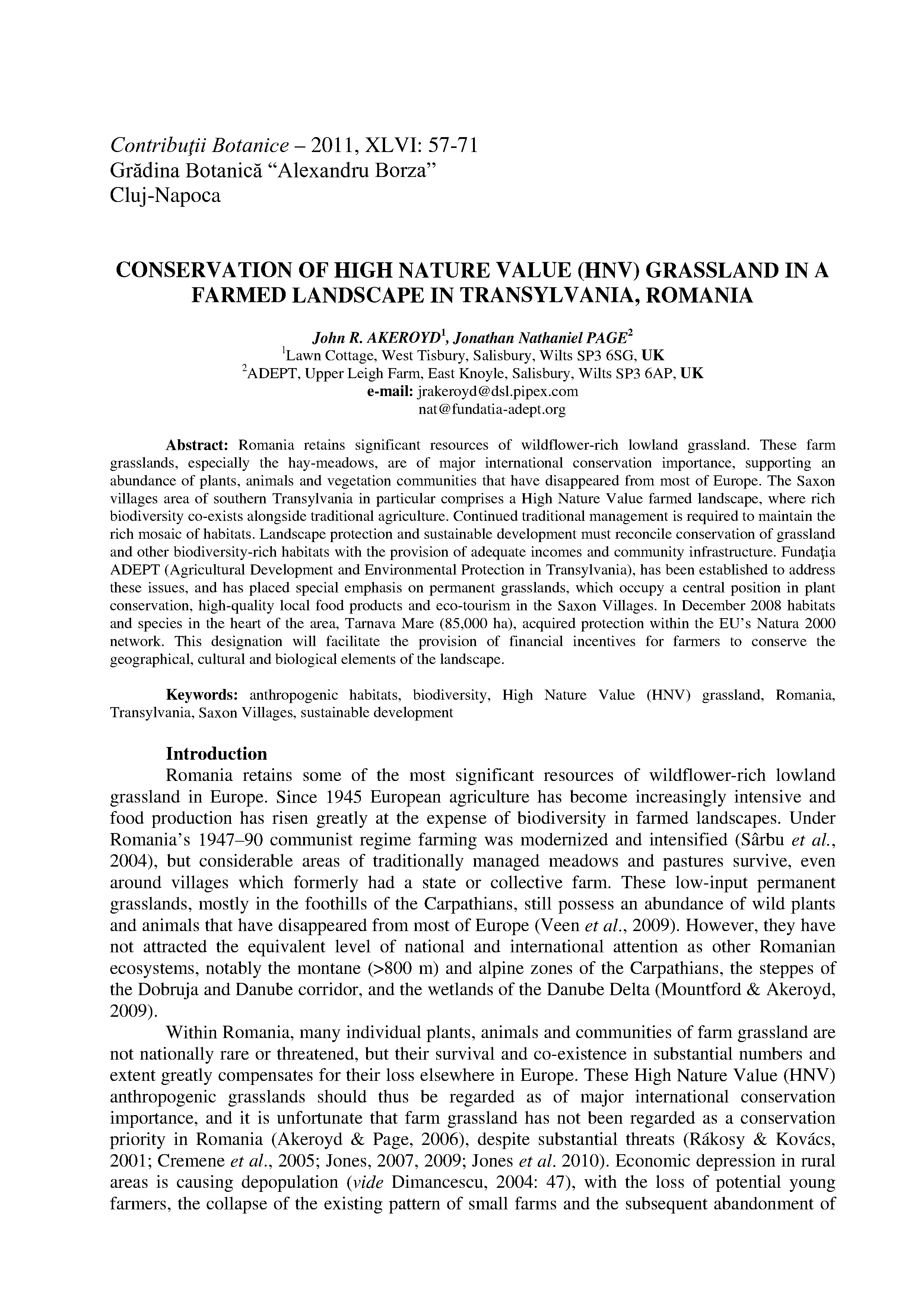Thư viện tri thức trực tuyến
Kho tài liệu với 50,000+ tài liệu học thuật
© 2023 Siêu thị PDF - Kho tài liệu học thuật hàng đầu Việt Nam

Tài liệu đang bị lỗi
File tài liệu này hiện đang bị hỏng, chúng tôi đang cố gắng khắc phục.
Conservation of high nature value (hnv) grassland in a farmed landscape in transylvania, romania
Nội dung xem thử
Mô tả chi tiết
Contribuiii Botanice - 2011, XLVI: 57-71
Gradina Botanica "Alexandra Borza"
Cluj-Napoca
CONSERVATION OF HIGH NATURE VALUE (HNV) GRASSLAND IN A
FARMED LANDSCAPE IN TRANSYLVANIA, ROMANIA
John R. AKEROYD', Jonathan Nathaniel PAGE
'Lawn Cottage, West Tisbury, Salisbury, Wilts SP3 6SG, UK
2ADEPT, Upper Leigh Farm, East Knoyle, Salisbury, Wilts SP3 6AP, UK
e-mail: [email protected]
Abstract: Romania retains significant resources of wildflower-rich lowland grassland. These farm
grasslands, especially the hay-meadows, are of major international conservation importance, supporting an
abundance of plants, animals and vegetation communities that have disappeared from most of Europe. The Saxon
villages area of southern Transylvania in particular comprises a High Nature Value farmed landscape, where rich
biodiversity co-exists alongside traditional agriculture. Continued traditional management is required to maintain the
rich mosaic of habitats. Landscape protection and sustainable development must reconcile conservation of grassland
and other biodiversity-rich habitats with the provision of adequate incomes and community infrastructure. Fundatia
ADEPT (Agricultural Development and Environmental Protection in Transylvania), has been established to address
these issues, and has placed special emphasis on permanent grasslands, which occupy a central position in plant
conservation, high-quality local food products and eco-tourism in the Saxon Villages. In December 2008 habitats
and species in the heart of the area, Tarnava Mare (85,000 ha), acquired protection within the EU' s Natura 2000
network. This designation will facilitate the provision of financial incentives for farmers to conserve the
geographical, cultural and biological elements of the landscape.
Keywords: anthropogenic habitats, biodiversity, High Nature Value (HNV) grassland, Romania,
Transylvania, Saxon Villages, sustainable development
Introduction
Romania retains some of the most significant resources of wildflower-rich lowland
grassland in Europe. Since 1945 European agriculture has become increasingly intensive and
food production has risen greatly at the expense of biodiversity in farmed landscapes. Under
Romania's 1947-90 communist regime farming was modernized and intensified (Sarbu et al.,
2004), but considerable areas of traditionally managed meadows and pastures survive, even
around villages which formerly had a state or collective farm. These low-input permanent
grasslands, mostly in the foothills of the Carpathians, still possess an abundance of wild plants
and animals that have disappeared from most of Europe (Veen et al., 2009). However, they have
not attracted the equivalent level of national and international attention as other Romanian
ecosystems, notably the montane (>800 m) and alpine zones of the Carpathians, the steppes of
the Dobruja and Danube corridor, and the wetlands of the Danube Delta (Mountford & Akeroyd,
2009)
Within Romania, many individual plants, animals and communities of farm grassland are
not nationally rare or threatened, but their survival and co-existence in substantial numbers and
extent greatly compensates for their loss elsewhere in Europe. These High Nature Value (HNV)
anthropogenic grasslands should thus be regarded as of major international conservation
importance, and it is unfortunate that farm grassland has not been regarded as a conservation
priority in Romania (Akeroyd & Page, 2006), despite substantial threats (Rakosy & Kovacs,
2001; Cremene et al., 2005; Jones, 2007, 2009; Jones et al. 2010). Economic depression in rural
areas is causing depopulation (vide Dimancescu, 2004: 47), with the loss of potential young
farmers, the collapse of the existing pattern of small farms and the subsequent abandonment of